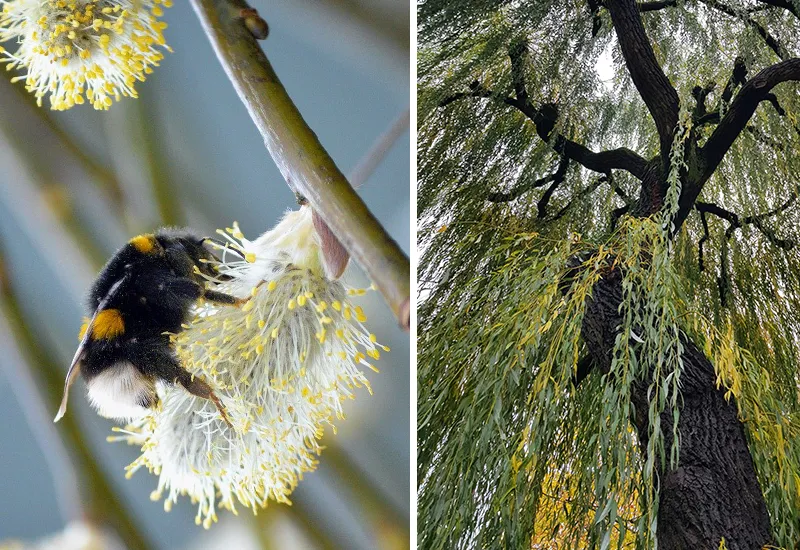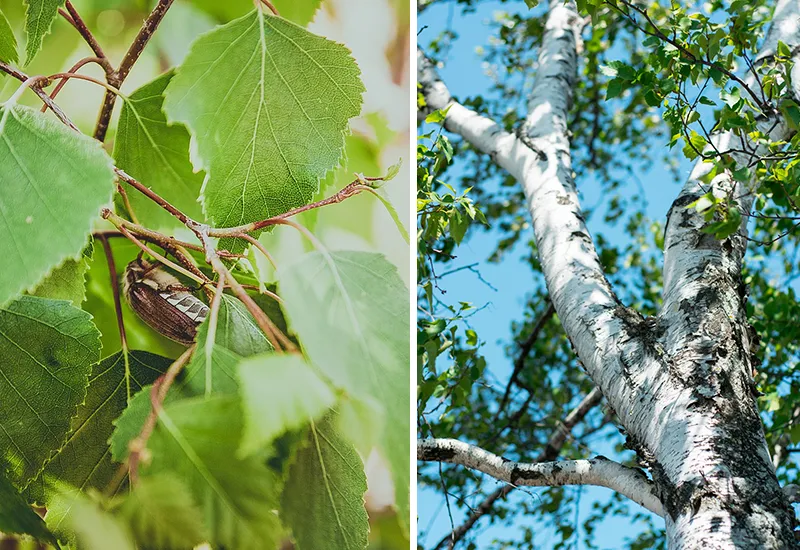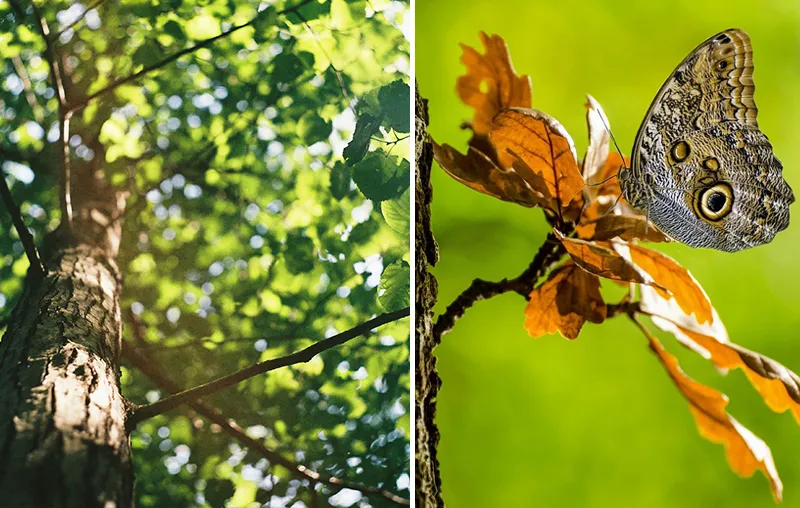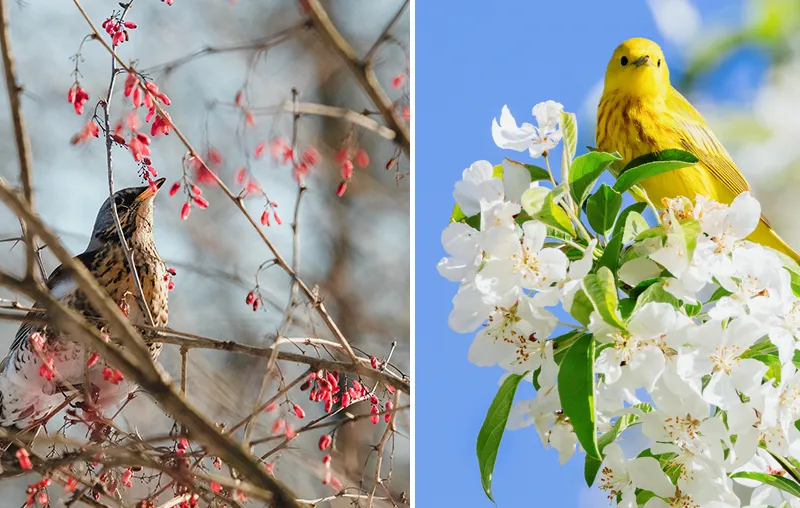Which trees are insect-friendly? If you're looking for a clear answer to this question, you've come to the right place! At a time when insects are becoming increasingly extinct, which also threatens us humans, it is more important than ever to act in an environmentally conscious manner.
As the decline in pollinating wild bees, butterflies, bumblebees, beetles and other insects is mainly due to the loss of habitats, amateur gardeners have a wonderful opportunity to make a real difference for the little creatures and therefore also for the environment by planting native, insect-friendly tree species in their own gardens. Biodiversity to make.
In this article, I will therefore introduce you to the most insect-friendly trees and large shrubs that grow naturally here in Europe. Plant them to help the insects. Let's go!
1. Willows (Salix)

Willows are true Hotspots of biodiversity and a must for all gardening enthusiasts (with enough space) who enjoy the Stop insect mortality want. Their early flowers offer a high pollen and nectar value at a time when few other food sources are available.
Willow is one of the most important food plants, especially for butterflies. But also countless butterflies and moths, bumblebees, wild bees, caterpillars, hoverflies and beetles love the tree.
Ich persönlich kenne keine andere Baumart, die so gut für Insekten ist. Da es unterschiedliche Weiden gibt, habe ich dir hier aber noch einmal die in Deutschland (bzw. Europa) ökologisch wertvollsten Arten compiled:
- Goat Willow (Salix caprea, is available here*)
- Eared Willow (Salix aurita; ideal for slightly smaller gardens; is available here*)
- Basket Willow (Salix viminalis, is available here*)
- Crack Willow (Salix fragilis, is available here*)
- Grey Willow (Salix cinerea, is available here*)
- Rosemary Willow (Salix rosmarinifolia, is available here*)
- Purple Willow (Salix purpurea, is available here*)
- White Willow (Salix alba, is available here*)
2. English Oak (Quercus robur)
Anyone researching insect-friendly trees cannot avoid the German oak (also known as the pedunculate oak). It is not only bird-friendly and a symbol of permanence, but also a Habitat for hundreds of insect species.
According to the Bavarian State Institute for Forestry and Forest Economics (LWF) the impressive tree is the home of around 400 species of butterflies, more than 50 species of longhorned beetles and around ten species of bark beetles and longhorned beetles.1 Insects especially love its wood and leaves.
You can buy the native oak in plant shops or here online at the Horstmann nursery*.
Good to know: There are also some oak trees in the garden center that are not native and therefore not particularly valuable for local insects. These include, for example, the Hungarian Oak (Quercus frainetto) or the Swamp White Oak (Quercus bicolor). It is therefore best to make a conscious decision in favor of the English Oak.
3. Common Beech (Fagus sylvatica)
The common beech (often simply called beech or copper beech) is another tree to choose from that is home to a variety of insect species. Above all Ants, moths, beetles, flies and caterpillars love their leaves, buds and bark. The latter is also very smooth and therefore an ideal habitat for lichens and mosses, which attract other insects.
When choosing, however, make sure you use the correct botanical name. Garden centers often sell (non-native) neophytes such as the Oriental beech (Fagus orientalis) or the American beech (Fagus grandifolia), which are of no value to insects in Central Europe.
You can buy the common beech locally at the plant market or here online at the Horstmann nursery*.
Good to know: The Weeping Beech (Fagus sylvatica "Pendula"), the Fernleaf Beech (Fagus sylvatica "Asplenifolia") or the Copper Beech (Fagus sylvatica "Purpurea") are alternative varieties of the native wild form. However, if you have enough space, I think you should opt for the common beech.
4. Lime Trees (Tilia)
A real Insect magnet is also the lime tree, under which the buzzing of insects can be heard particularly well in the warm season. This is because its flower nectar attracts bumblebees, beetles, moths and wild and honey bees. The lime leaves also serve as a food source for the caterpillars of many butterfly species.
Da zum Beispiel die Amerikanische Linde (Tilia americana) nicht bei uns zu Hause und ihr ökologischer Wert gering ist, solltest du dich bewusst für one of the following native lime trees decide:
- Large-Leaved Lime (Tilia platyphyllos, is available here*)
- Small-Leaved Lime (Tilia cordata, is available here*)
- Common Lime (Tilia x europaea)
5. Fruit Trees (Malus; Prunus; Pyrus)

The blossoms of fruit trees (especially cherries, apples, plums and pears) not only delight us humans, but also countless pollinators. Their abundant and often luxuriant blossoms offer above all Wild bees, beetles, caterpillars and flies an important food source in the form of nectar and pollen.
Ideally, you should opt for the respective wild form. Doch auch die entsprechenden Kultursorten hat im Gegensatz zu Zierpflanzen einen hohen Wert für heimische Insekten.
So simply choose from the following insect-friendly fruit trees:
- European Wild Apple (Malus sylvestris, is available here*)
- Cultivated Apple (Malus domestica; e.g. "Elstar", is available here*)
- Greengage Plum (Prunus domestica subsp. italica, is available here*)
- Common Plum (Prunus domestica; e.g. "Stanley", is available here*)
- Wild Cherry (Prunus avium; also called sweet cherry or cherry, is available here*)
- European Wild Pear (Pyrus pyraster)
- Common Pear (Pyrus communis; not native, however; is available here*)
6. Blackthorn (Prunus spinosa)
Blackthorn is not only important for many bird species, but is also a absolute insect magnet.
The early bloomer offers countless Bumblebees, wild bees, caterpillars, butterflies (e.g. lemon butterfly and peacock butterfly), Hoverflies and beetles a first source of nectar in spring. And the dense thorn hedges serve as protection for their nests and larvae.
You will find the sloe in well-stocked plant markets or also here online at the Horstmann nursery*.
7. Poplars (Populus)
With their soft, drooping leaves, native poplars provide food for butterfly caterpillars and beetles in particular. The Bavarian State Institute for Forestry and Forest Economics assigns them over 500 beetles and 87 large butterflies to. The nectar and pollen of the deciduous tree are also important for some species of wild bees and hoverflies.
You should definitely avoid the invasive Canadian Poplar (Populus canadensis), as it threatens biodiversity. Instead, choose from the following poplars for your gardenwhich are native to Central Europe:
- Aspen (Populus tremula, is available here*)
- Black Poplar (Populus nigra)
- White Poplar (Populus alba)
8. Hawthorn (Crataegus)
If you want your own greenery to really hum and buzz, then you should definitely plant a hawthorn. This native, thorny tree or large shrub attracts mainly Wild bees and hoverflies for pollination and provides valuable nectar for Caterpillars and butterflies. Moths, bugs and wasps also love it.
Simply choose one of the the following two species of hawthornwhich basically differ only in the number of pistils in the ovary:
- Common Hawthorn (Crataegus monogyna, is available here*)
- Midland Hawthorn (Crataegus laevigata, is available here*)
Tip: The hawthorn also provides food and shelter for feathered garden animals - and is therefore one of the most bird-friendly trees in the garden. You can find out which other trees are included in the linked blog post.
9. Maple Trees (Acer)
If you are looking for insect-friendly trees, the maple is definitely something for you. This native deciduous tree is not only an important bird protection and food tree, but also attracts many insects that feed on its nectar, pollen and leaves. Both Wild bees, as well as beetles, caterpillars, butterflies and hoverflies love him.
However, with the Japanese Maple (Acer japonicum) or the Box Elder (Acer negundo), among others, there are some maple species that are not native to Central Europe are. The latter is even invasive and displaces native species.
It is therefore better to decide for the following native trees:
- Field Maple (Acer campestre, is available here*)
- Sycamore Maple (Acer pseudoplatanus, is available here*)
- Montpellier Maple (Acer monspessulanum)
- Italian Maple (Acer opalus)
Tip: With the Norway Maple 'Globosum' (Acer platanoides "Globosum") or conical Field Maple 'Elsrijk' (Acer campestre "Elsrijk"), there are also somewhat more space-saving varieties of the wild form of the maple. They are well suited to smaller gardens and are also valuable for insects.
10. Birches (Betula)

The birch is another native tree and is known for its white bark. They is one of the most popular tree species in the insect worldeven if they are not quite as interesting for bees due to wind pollination. It is rather the leaves of the birch that attract beetles, caterpillars and butterflies.
Since it verschiedene Birkenarten I have compiled the most ecologically valuable, local varieties for you here:
- Silver Birch (Betula pendula, is available here*)
- Downy Birch (Betula pubescens, is available here*)
- Weeping Birch (Betula pendula "Youngii", is available here*)
- Dwarf Birch (Betula humilis)
- Low Birch (Betula nana)
Good to know: However, the Japanese White Birch (Betula maximowicziana), the Ribbed Birch (Betula costata) and the Mongolian Birch (Betula dahurica) are not native. It is therefore essential to pay attention to the correct botanical name when buying in the plant center.
Know insect-friendly trees and plant them in your garden!
Now you know which trees are best for a really insect-friendly garden are suitable. Remember that every small decision makes a valuable difference. Contributing to the preservation of biodiversity and that trees need time to grow.
By directly and specifically Choose tree species that attract and support pollinatorsyou will definitely live up to your responsibility - and can enjoy the buzz from the hammock.
"Any stupid boy can crush a beetle. But all the professors in the world can't make one."
Arthur Schopenhauer (more at Environmental protection quotes)
Hast du jetzt richtig Lust auf einen Naturgarten bekommen? Dann möchte ich dir abschließend noch unbedingt das Buch "Wild & colorful: Designing natural gardens with native plants" an die Hand geben. Wenn du magst, get it here*.
Und noch etwas! Möglicherweise sind einige der genannten Bäume etwas zu groß für deinen Garten. Dann wirf unbedingt auch noch einmal einen Blick in meinen Artikel über Insect-friendly small trees for small gardens! 🙂
Do you have any questions, suggestions or do you know of other trees that insects love? Then I look forward to your comment.
Stay insect-friendly and close to nature,

PS: Are you missing the butterfly bush in this list? It looks beautiful and actually attracts butterflies magically - but the Tree is an invasive neophyte, die heimische Arten verdrängen. Deshalb solltest du ihn nicht im Garten pflanzen. Welche Bäume sonst noch invasiv sind und welche Alternativen es gibt, erfährst du als Nächstes im verlinkten Beitrag.
References:
- H. Mühle; LWF aktuell 60/2007: Wald-Wissenschaft-Praxis: Die Eiche – EI Dorado für Insekten, abrufbar unter https://www.lwf.bayern.de/mam/cms04/service/dateien/a60_die_eiche-el_dorado_fuer_insekten.pdf. [19.03.2025]. ↩︎






